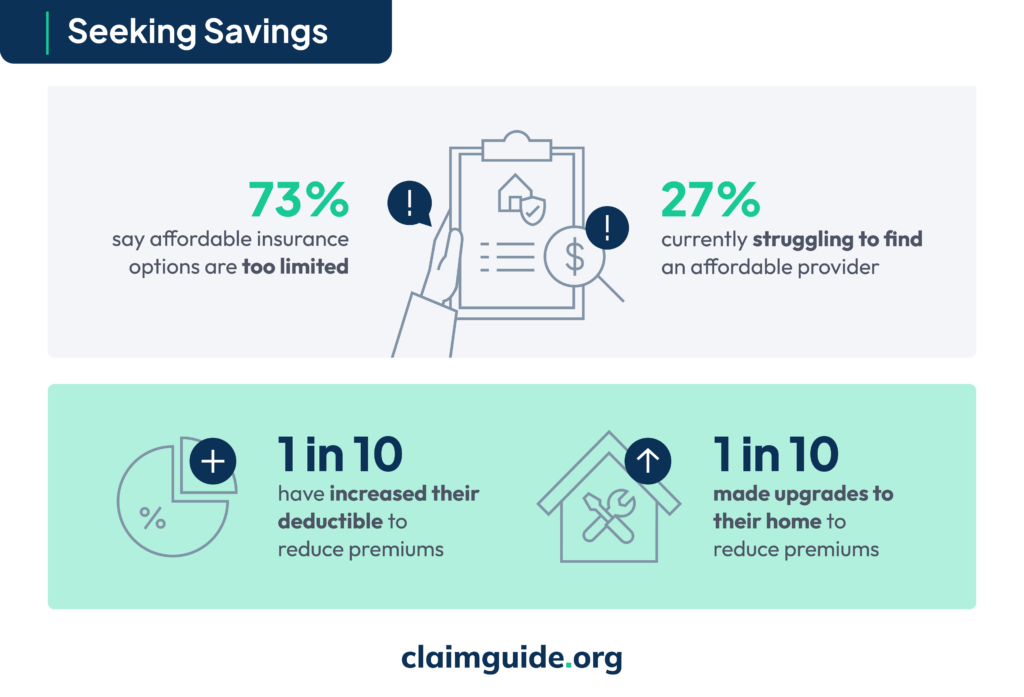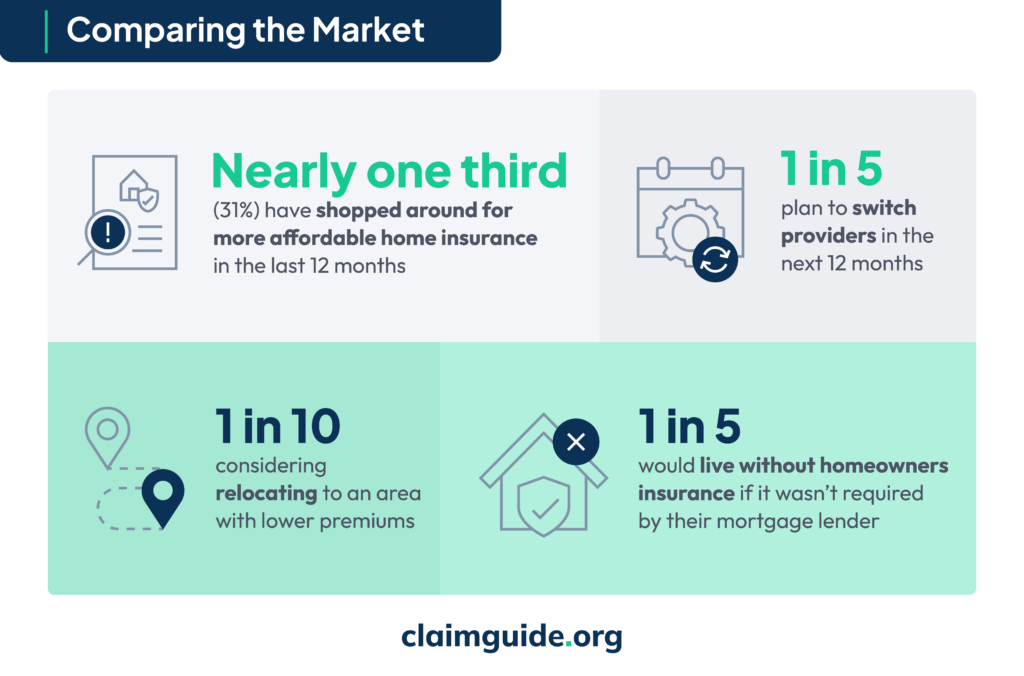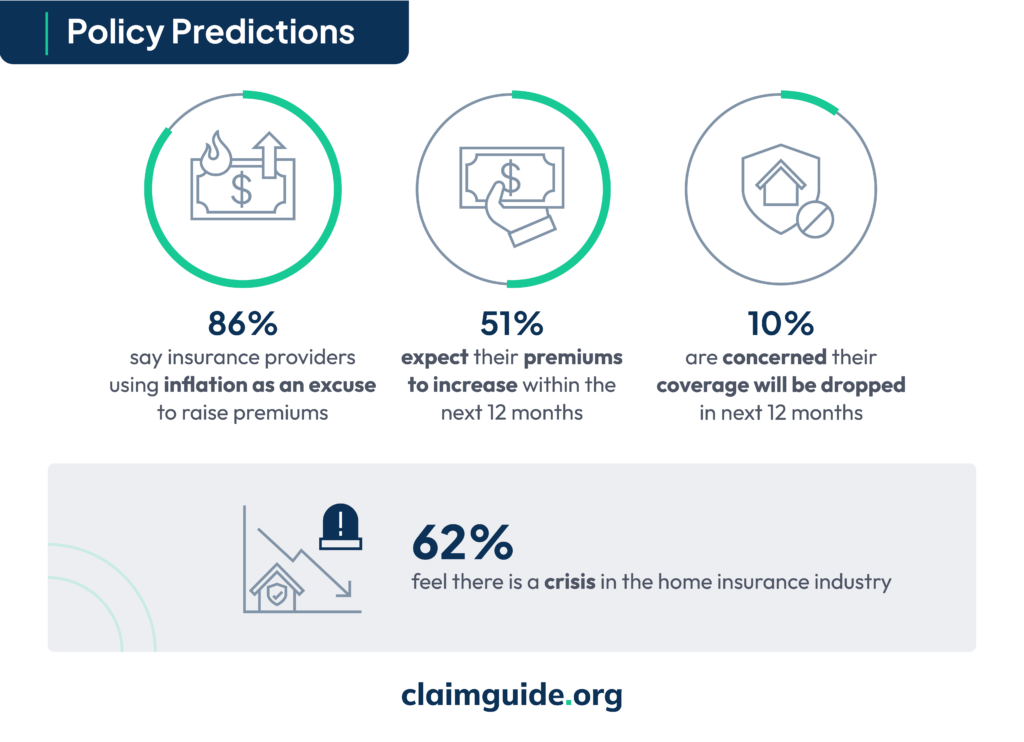Premium Pains: Rising Cost of Homeowners Insurance
If you’re a homeowner, you’ve likely noticed an increase in your homeowners insurance premiums.
Within the last five years, homeowners insurance premiums have spiked by 34% nationwide, according to S&P Global Market Intelligence. In 2023, rates increased by 11.3%, with states like Texas (23.3%) and Arizona (21.8%) experiencing the highest surges.
For some homeowners, these rate hikes are forcing difficult decisions, such as cutting back on expenses, dropping policies, and even forgoing home insurance coverage altogether.
But just how severely are homeowners feeling the home insurance premium pains across the country? We surveyed 1,500 homeowners across the country to gain insight into the rising cost of home insurance.
Key Findings
- 61% say their home insurance premium has increased in the last 12 months.
- Nearly 1 in 4 (23%) have cut back on expenses to pay for rising premium costs.
- More than one quarter (27%) are currently struggling to find an affordable provider.
- 1 in 5 would live without homeowners insurance if it wasn’t required by their mortgage lender.
- 1 in 5 plan to switch providers in the next 12 months.
- On average, survey respondents reported paying $166.41 per month ($1,997 annually) for home insurance coverage.
Rising Cost of Home Insurance

Responses to the premium bubble are almost as varied as American homeowners themselves, but some clustered behaviors are evident. First, 61% of respondents noted an increase in their premium over the last 12 months, and nearly a quarter of respondents (23%) have adjusted their spending habits in response.
Some are choosing to rebalance the cost in other ways. Overall, 1 in 10 have increased their deductible to reduce their premiums, and a further 1 in 10 have made upgrades to their homes to reduce premiums.
Then there are those who would rather ditch their provider altogether. Among our 1,500 survey respondents, 1 in 5 plans to switch providers in the next 12 months, and 1 in 5 indicated that they would drop coverage altogether if it weren’t required by their mortgage lender.
Among the homeowners we surveyed, well over half (61%) reported an increase in their homeowners insurance over the last 12 months. Some noted a substantial increase – more than 1 in 10 say their premium has doubled or more than doubled in that timeframe.
In response to these changes, nearly 1 in 4 respondents say they have cut back on everyday expenses, with 90% forgoing dining out, 81% postponing travel plans, 61% cutting back on grocery expenses, and 21% even taking the step of reducing medications to make up the difference.
Can Homeowners Find Affordable Home Insurance?

When shopping around for home insurance, many consumers find themselves disappointed: nearly 3 in 4 (73%) agree that affordable options are too limited, and more than one quarter (27%) say they are currently struggling to find an affordable provider.
Among those who are already insured, just 16% say they have looked for another provider in direct response to their rising premium. Instead, rebalancing deductibles, home repairs, and premiums is a juggling act some are willing to take on. Among homeowners, 1 in 10 say they have increased their deductible to reduce premiums, and a further 1 in 10 have made upgrades to their homes in a gambit to reduce their premiums.
If you’re able to afford the investment, making upgrades to your home can lower your premiums, according to ClaimGuide.org insurance specialist, Gerard Reczek, who has more than 40 years of experience as a broker and underwriter.
“Roof updates to meet new wind guidelines for coastal properties and other high wind areas affords homeowners additional protection and can reduce insurance cost,” said Reczek, “Insurance companies will lower premiums and reduce wind deductibles with recommended roof construction improvements.”
Changing Home Insurance Providers

A natural response to the increased cost is to look for other providers, and nearly 1 in 3 (31%) of our survey respondents have done so in the last 12 months. Further, 1 in 5 say they have plans to switch providers in the next 12 months, and some are even more bold: 1 in 5 say they would live without homeowners insurance if it wasn’t required by their mortgage lender.
What’s to blame for the rising costs? Aside from suspicions of greed on the part of providers (40% alleged this), another force might be at play – climate change. Two thirds of those surveyed believe the increase in severe weather damage and climate threats has caused premiums to increase, and 1 in 10 would consider relocating to a more favorable market with lower premiums.
Whatever the cause, a strong majority (73%) agree that the home insurance industry needs more robust regulations in place.
Will Homeowners Insurance Continue to Rise?

More than 6 in 10 (62%) say there is a crisis in the home insurance industry, and many feel that the consequences of this crisis are still looming. When asked to predict developments over the next 12 months, 51% say they expect their premiums to increase, and 1 in 10 are concerned their coverage will be dropped entirely.
This coincides with an overall distrust of the industry and its rationales. A majority of homeowners (86%) say insurance providers are using inflation as an excuse to raise premiums.
Homeowners Living Without Insurance
Whether home insurance premiums have slashed your necessities budget, or you’d rather pocket the monthly payments to afford improvements as needed, “going bare,” or completely forgoing homeowners insurance, is on the rise.
Nationwide, more than 10.6 million homeowners live without home insurance, which is roughly 7.4% of homeowners.
Nowhere is “going bare” more popular than in Mississippi, where 13.3% of homeowners are uninsured. The Magnolia State is closely followed by New Mexico (12.9% uninsured), West Virginia (12.3%), and Louisiana (12.0%), all of which are susceptible to environmental disasters that could cause property damage, including hurricanes, wildfires, and floods.
Coastal states and regions are generally least willing to risk a coverage gap, with Washington, D.C. claiming the highest insurance rate – just 3.3% of homeowners are uninsured. Oregon (4.7% uninsured), California (4.9%), Massachusetts (5.4%), and New York (5.4%) are similarly risk averse.
Nearly all mortgage lenders require homebuyers to have home insurance coverage. However, if your home is already paid off, there is no requirement to have coverage. Living without home insurance comes with consequences, such as costly expenses if your home is damaged due to weather or another type of disaster.
Living without home insurance is a drastic measure, but there are safer ways to reduce your insurance premiums. One of the easiest ways is to decrease your deductible, which will lower your premium. Investing in home security, as well as updating your home’s infrastructure such as wiring and plumbing, are additional ways that can help save you money in the long run.
Also, filing a homeowners insurance claim can increase your premiums, so make sure you’re taking a calculated approach before you file a claim. If the repair costs are roughly the same as your deductible, it’s probably best to pay for them out of pocket.
Homeowners should also take the time to review their insurance policy on each renewal at a minimum, according to Reczek.
“Reviewing your insurance policy is always prudent,” said Reczek. “Understanding potential hazards and exposures to your area and home allows you to address any concerns in advance. Reading policy exclusions for flood, wind, and earthquake will direct you to policy limitations you should address. Taking ownership in policy coverage and policy exclusions should prevent any surprises after a loss.”
Climate change, rising construction costs, and inflation have all contributed to the increasing cost of home insurance. But taking extra time to research your options and making improvements to your home are a few ways to give yourself some financial relief.
Methodology
In May 2024, we conducted a nationwide survey of 1,500 American homeowners to gain insight into the rising cost of home insurance premiums. The survey respondents included 40% males, 59% females, and 1% identifying as non-binary/non-conforming. The average age of respondents was 46 years. The survey responses rely on self-reporting, which may be subject to recall bias or social desirability bias. The collected data underwent quantitative analysis to identify trends, patterns, and correlations related to home insurance costs.
Income: Under $25,000 (6%); $25,000-$34,999 (7%); $35,000-$49,999 (9%); $50,000-$74,999 (21%); $75,000-$99,999 (19%); $100,000-$149,999 (23%), $150,000 or over (15%).
In order to identify which states have the highest percentage of homeowners without home insurance, we analyzed housing data from the U.S. Census Bureau American Community Survey (ACS) Public Use Microdata Sample (PUMS) 2022.
Sources: U.S. Census Bureau American Community Survey (ACS) Public Use Microdata Sample (PUMS) 2022, S&P Global Market Intelligence
Fair Use: Feel free to use this data and research with proper attribution linking to this study.
Media Inquiries: For media inquiries, contact [email protected]